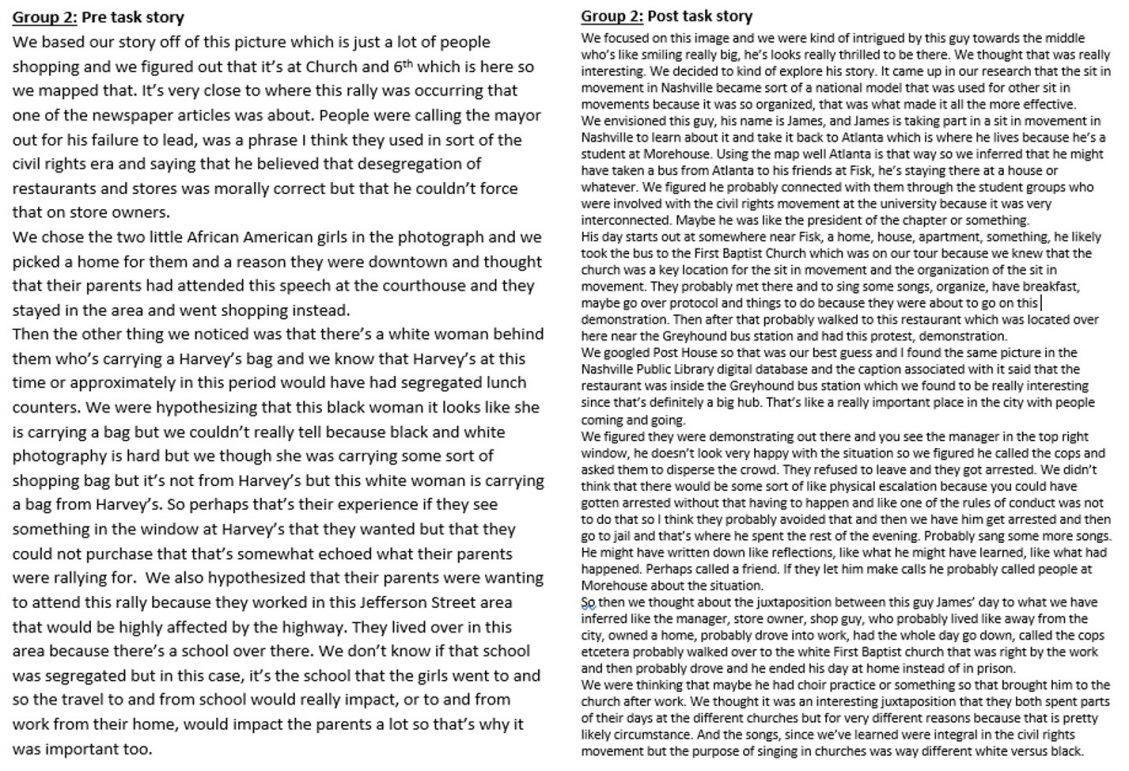Our research supports an argument for storytelling as a tool and practice, which provides a new way to engage people in learning about local history. Data analysis gathered during iterations using the framework indicates that the practice of storytelling as part of the curation and sharing of map-based story tours allowed participants to develop an understanding of history as a perspective on the past as opposed to a set of facts to be learned. We suggest the increased sense of agency which students demonstrated in their choice of story theme and selection of their own media helped them to view history as a version of events told from someone’s point of view.
The intellectual toolkit which students work with as part of the DSSL framework contains conceptual tools for making sense of their place in the world, which is especially relevant to students who have developed master or schematic narratives from interactions with only dominant accounts of the past. The contextual historical knowledge and understanding, and the conceptual tools students utilize during their storyline research, curation and sharing challenge their preexisting schematic narratives. Over time, the DSSL framework may enable them to develop a more sophisticated understanding of history and their place in the historical present (Wills, 2011; O’Neill, Guloy & Sensoy, 2014).
The pre- and post-task ‘Day in the Life’ story telling activities can be used by educators as an assessment of learning within the DSSL framework. From analyzing the pre- and post-task stories which groups have produced, we have found that students’ learning appears to develop in a number of ways:
•Recall of historical facts and dates increases
•Spatial awareness of city streets, neighborhoods and regions increases
•Post-task stories are longer and more developed than pre-task stories
•Post-task stories include multiple perspectives indicating that students appreciate that a historical narrative is a perspective on the past from a particular point of view
•Students report finding the post-task easier than the pre-task as they have better historical contextual understanding and have increased agency when authoring historical fiction.
•Participants ask more questions about the past, including those which challenge the version of history they are reading and the perspective that has been represented in the archival material.

Carretero, M., & Van Alphen, F. (2014). Do master narratives change among high school students? A characterization of how national history is represented. Cognition and Instruction, 32(3), 290-312.
Mulholland, P., Collins, T., & Zdrahal, Z. (2004, January). Story fountain: intelligent support for story research and exploration. In Proceedings of the 9th international conference on Intelligent user interfaces(pp. 62-69). ACM.
O’Neill, D. K., Guloy, S., & Sensoy, Ö. (2014). Strengthening methods for assessing students’ metahistorical conceptions: Initial development of the historical account differences survey. The Social Studies,105(1), 1-14.
Procyk, J., & Neustadter, C. (2014). GEMS: The design and evaluation of a location-based storytelling game. In Proceedings of the 17th ACM conference on Computer supported cooperative work & social computing,1156-1166. ACM.
Refsland, S. T., Tuters, M., & Cooley, J. (2007). Geo-storytelling: A living archive of spatial culture. In F. Cameron & S. Kenderdine (Eds.). Theorizing digital cultural heritage: A critical discourse, 409-416. Cambridge, MA: The MIT Press.
Resor, C. W. (2010). Place-based education: What is its place in the social studies classroom. The Social Studies, 101, 185-188.
Robin, B. (2006). The educational uses of digital storytelling. In Society for Information Technology & Teacher Education International Conference (pp. 709-716). Association for the Advancement of Computing in Education (AACE).
Sakr, M., Jewitt, C., & Price, S. (2016). Mobile experiences of historical place: A multimodal analysis of emotional engagement. Journal of Learning Sciences, 25(1),51-92.
Solorzano, D. G., & Yasso, T. J. (2002). Critical race methodology: Counter-storytelling as an analytical framework for education research. Qualitative Inquiry, 8(1), 23-44.
Taylor, K. H., & Hall, R. (2013). Counter-mapping the neighborhood on bicycles: Mobilizing youth to reimagine the city. Technology, Knowledge and Learning,18(1-2), 65-93.
van Alphen, F., & Carretero, M. (2015). The construction of the relation between national past and present in the appropriation of historical master narratives. Integrative Psychological and Behavioral Science, 49(3), 512-530.
Wills, J. S. (2011). Misremembering as mediated action: Schematic narrative templates and elementary students’ narration of the past. Theory & Research in Social Education, 39(1), 115-144.
Wineburg, S. S. (1991). Historical problem solving: A study of the cognitive processes used in the evaluation of documentary and pictorial evidence. Journal of educational Psychology, 83(1), 73.